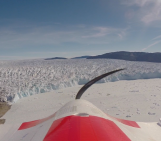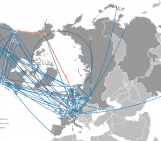
As the days get very long, summer is a popular season for conducting fieldwork at high latitudes. At the North East Greenland Ice Stream (NEGIS), the East Greenland Ice-core Project (EastGRIP) is ongoing. Several scientists are busy drilling an ice core through the ice sheet to the very bottom, in continuation to previous years (see here and here). This year, amongst others, several members from the European Research Council (ERC) supported synergy project ice2ice are taking part in the work at EastGRIP. Besides sleeping in the barracks that can be seen in our Image of the Week, the scientists enjoy the international and interdisciplinary setting and, of course, the work in a deep ice core drilling camp…
Life at the EastGRIP camp
In total, 22 people live in the camp (see Fig.2): 1 field leader, 5 ice core drillers, 4 ice core loggers, 3 people working with the physical properties of the ice, 2 are doing continuous water isotope analysis, 2 surface science scientists, 2 field assistants, and 1 mechanic, 1 electrical engineer and most important an excellent cook. We cover a variety of nationalities: British, Czech, Danish, French, German, Japanese, Korean, Norwegian, Russian and more. The crew changes every four weeks and the EastGRIP project aims to get as many young scientists (Master and PhD students) into camp as possible, so that it also works as a learning environment for new generations. In total, the number of people that have and will spent time at EastGRIP this season is almost 100, making it a buzzing science hub. This environment leads to extensive science discussions over the dinner table and therefore facilitates the interdisciplinary connections so vital in ice core science.

Fig.2: The current crew at EastGRIP dressed up for the Saturday party (tie and dress obligatory!) [Credit: EastGRIP diaries].
Science at the EastGRIP camp
The main aim of the EastGRIP project is to retrieve an ice core by drilling through the North East Greenland Ice Stream (NEGIS) up to a depth of 2550 m (!). Ice streams are responsible for draining a significant fraction of the ice from the Greenland Ice Sheet (see Fig. 3). We hope to gain new and fundamental information on ice stream dynamics from the project, thereby improving the understanding of how ice streams will contribute to future sea-level change. The EastGRIP project has many international partners and is managed by the Centre for Ice and Climate, Denmark with air support carried out by US ski-equipped Hercules aircraft managed through the US Office of Polar Programs, National Science Foundation.

Fig. 3: Ice velocities from RADARSAT synthetic aperture radar data are shown in color and illustrate the wedge of fast-flowing ice that begins right at the central ice divide and cuts through the ice sheet to feed into the ocean through three large ice streams (Nioghalvfjerds isstrømmen, Zachariae isbræ, and Storstrømmen). [Credit: EastGRIP, data from Joughin et al., 2010]
unity for us in ice2ice to learn more about how the fast-flowing ice stream in North East Greenland may influence the stability of the Greenland ice cap and to enjoy the collaborative spirit at an ice core drilling site.
This year’s fieldwork at EastGRIP started in May and will continue until August. We aim to make it through the brittle zone of the ice. This is a zone where the gas bubbles get enclosed in the ice crystals and thus the ice is, as the name indicates, more brittle than at other depths. Unfortunately for us, the brittle zone makes it very hard to retrieve the ice in a great quality. This is because of the pressure difference between the original depth of the ice and the surface, that causes the ice to fracture when it arrives at the surface. We are doing our very best to stabilize the core and several optimizations in terms of both drilling and processing of the ice core are being applied.
Still, a large part of the core can already be investigated (see Fig. 4) for water isotopes to get information about past climate. Also, ice crystals directions are being investigated through thin slices of the ice core to help better understanding the flow of the NEGIS. On top of the deep ice core, which is to be drilled to bedrock over the coming years, we are doing an extensive surface program to look at accumulation changes.In the large white plains…
Despite all the fun science and people, when you are at EastGRIP for more than 4 weeks, you have a very similar landscape everyday and can miss seeing something else than just the great white. About a week ago, a falcon came by to remind us of the rest of the world (see Fig. 5). It flew off after a couple of days. We will follow its path to the greener parts of Greenland when we will soon fly down to Kangerlussuaq. Someone else will then take over our job at EastGRIP and enjoy the wonders of white…
Further reading
- EastGRIP website
- ice2ice website
- Image of the Week – Science and Shovels: Traversing across the Greenland Ice Sheet
- Image of the Week – Ballooning on the Ice
Edited by Clara Burgard
 Helle Astrid Kjær is a postdoc at the Centre for Ice and Climate at the Niels Bohr Institute at University of Copenhagen. When she is not busy in the field drilling and logging ice cores, she spends most of her time in the lab retrieving the climate signal from ice cores. These include volcanic events, sea salts, dust with more by means of Continuous Flow Analaysis (CFA). Further she is hired to manage the ice2ice project.
Helle Astrid Kjær is a postdoc at the Centre for Ice and Climate at the Niels Bohr Institute at University of Copenhagen. When she is not busy in the field drilling and logging ice cores, she spends most of her time in the lab retrieving the climate signal from ice cores. These include volcanic events, sea salts, dust with more by means of Continuous Flow Analaysis (CFA). Further she is hired to manage the ice2ice project.



![Lost in transl[ice]tion…](https://blogs.egu.eu/divisions/cr/files/2020/10/MainFigure-161x141.png)


